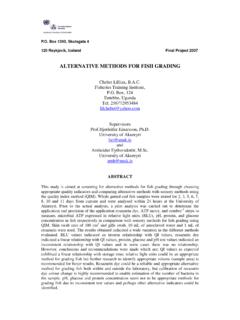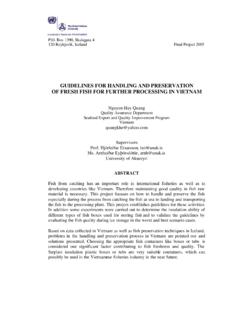Transcription of THE EFFECTS OF DISSOLVED OXYGEN ON FISH GROWTH IN …
1 Box 1390, Skulagata 4 120 Reykjavik, Iceland Final Project 2007 THE EFFECTS OF DISSOLVED OXYGEN ON FISH GROWTH IN AQUACULTURE Yovita John Mallya Kingolwira National Fish Farming Centre, Fisheries Division Ministry of Natural Resources and Tourism Tanzania. Supervisor Prof. Helgi Thorarensen Holar University College ABSTRACT Commercial aquaculture is growing worldwide except in Africa where production is still low. With fisheries reaching a stagnating phase, the world and more so Africa will have to look to aquaculture in the future to provide fish products that will likely be needed. In view of this, a study on water quality management was done which specifically looked at the EFFECTS of DISSOLVED OXYGEN saturation on fish GROWTH .
2 The study was done through a review of literature and a case study using Atlantic halibut. In the case study, halibut of 20-50 g in weight were reared in replicate at 60%, 80%, 100%, 120% and 140% OXYGEN saturation levels in a tank recirculation system. The subsequent effect of OXYGEN saturation levels on GROWTH and feed conversion ratios were taken after two weeks. The results showed that OXYGEN saturation level had a positive effect on the GROWTH and feed conversion ratio when it was set at 80%-120% saturation. At 140% the GROWTH was slightly lower and the feed conversion ratio was higher at 60% and 140% compared to the other groups. The conclusion was that OXYGEN saturation level has an effect on GROWTH and feed conversion ratios of fish, and in the case of Atlantic halibut, the GROWTH rate is higher when the OXYGEN level is between 80% and 120%.
3 The feed conversion ratio for halibut was lower at 120% OXYGEN saturation. Mallya UNU-Fisheries Training Programme 2 TABLE OF CONTENTS 1 INTRODUCTION .. 6 State of world aquaculture .. 6 Status of aquaculture in Africa .. 6 Status of aquaculture in Tanzania .. 6 Motivation .. 10 Objective of the study .. 10 Goals of the study .. 10 Research questions .. 10 2 LITERATURE REVIEW .. 11 Water quality in aquaculture .. 11 Gas exchange and OXYGEN concentration in water .. 11 OXYGEN uptake in and carbon dioxide release from the fish .. 11 Function of fish 12 EFFECTS of OXYGEN levels on OXYGEN uptake by fish .. 13 Fish response to hypoxia .. 14 Fish response to hyperoxia .. 15 EFFECTS of OXYGEN level on GROWTH and food conversion ratios of fish .. 15 effect of OXYGEN on fish GROWTH .. 16 effect of OXYGEN on the food conversion ratio in fish.
4 17 Tilapia (Oreochromis niloticus) .. 18 Cat fish culture (Clarias gariepinus) water quality requirements .. 20 OXYGEN deficiency .. 20 3 MATERIALS AND METHODS .. 21 Study area .. 21 Experimental fish .. 21 Experimental design .. 21 OXYGEN levels in the system .. 22 Sampling and measurements .. 24 Mallya UNU-Fisheries Training Programme 3 Specific GROWTH 24 Feeding and the collection of leftover feed .. 24 Feed conversion ratio (FCR) .. 24 4 RESULTS .. 25 GROWTH .. 25 Feed conversion ratio (FCR) .. 25 5 DISCUSSION .. 26 6 CONCLUSIONS .. 26 ACKNOWLEDGEMENTS .. 27 LIST OF REFERENCES .. 28 Mallya UNU-Fisheries Training Programme 4 LIST OF FIGURES Figure 1: The graph below shows total aquaculture production in Tanzania according to FAO statistics 2006b (redrawn with data from FAO Fishery Statistics, Aquaculture Production).
5 9 Figure 2: Diagram showing the structure for respiration (gas exchange) in fish. (Source: Microsoft 2008-02-08).. 12 Figure 3: The effect of OXYGEN level on GROWTH and food conversion ratios. (Source 2007).. 16 Figure 4: Weight increase of O. niloticus grown under high ambient OXYGEN (near air saturation) and under simulated conditions of diel flux in OXYGEN . Data from 2 separate sets of experiments (A and B) are indicated. Curves drawn through mean values ( SD; n = 8) indicated (see test). (Source: Tsadik and Kutty 1987) .. 19 Figure 5: Increase in weight of O. niloticus grown under high (near air saturation), medium and low ambient OXYGEN . Mean values ( SD; n = 8) are indicated (Source: Tsadik and Kutty 1987).. 19 Figure 6: The arrangement of the tank system used in the experiment, showing the OXYGEN saturation levels, inlet and outlet pipes, water pumps, food collector plates and aerators.
6 23 Figure 7: The graph showing the specific GROWTH rate (SGR) of Atlantic halibut reared at different OXYGEN saturation levels.. 25 Figure 8: The feed conversion ratios (FCR) of Atlantic halibut reared at different OXYGEN saturation levels.. 26 Mallya UNU-Fisheries Training Programme 5 LIST OF TABLES Table 2: Water quality requirements of African catfish .. 20 Mallya UNU-Fisheries Training Programme 6 1 INTRODUCTION State of world aquaculture The contribution of aquaculture to global supplies of fish, crustaceans, molluscs and other aquatic animals was growing at a rate of in 2004. Aquaculture continues to grow more rapidly than all other animal food-producing sectors. Production from aquaculture has greatly outpaced population GROWTH , with a per capita supply from aquaculture increasing from kg in 1970 to kg in 2004, representing an average annual GROWTH rate of %.
7 (FAO 2006a). According to (FAO 2006a) production in capture fisheries is stagnating and aquaculture output is expanding faster than any other animal-based food sector worldwide. Aquaculture is the fastest growing animal based food-producing sector, particularly in developing countries though it is not so fast growing in Africa as will be reviewed below. This sector alone contributes nearly a third of the world s supply of fish products. China and other Asian countries are by far the largest producers. Unlike terrestrial farming, where the bulk of the production is based on a limited number of species, aquaculture produces more than 220 species. Of these species, carps, tilapia and related fish form the largest group in terms of quantity. Other groups include aquatic plants and mollusc (FAO 2006 a).
8 Status of aquaculture in Africa The Sub-Saharan Africa region continues to be a minor player in aquaculture despite its natural potential. Even aquaculture of tilapia, which is native to the continent, has not developed to a large degree. Nigeria leads in the region with the production of 44,000 tonnes of catfish, tilapia and other freshwater fishes reported. There are some isolated bright spots in the continent: black tiger shrimp (Penaeus monodon) in Madagascar and Eucheuma seaweed in The United Republic of Tanzania are thriving, and production of niche species like abalone (Halitosis spp.) in South Africa is increasing. In North Africa and the Near East, Egypt is by far the dominant producing country (92% of the total for the region) and, in fact, it is now the second biggest tilapia producer after China and the world s top producer of mullets (FAO 2006a).
9 Status of aquaculture in Tanzania The history of fish culture in the United Republic of Tanzania is not well documented. According to Balarin (1985) in documents at sector/naso_tanzania, it started in 1949 with experimental work on the culture of tilapia at Korogwe (in Tanga Region) and Malya (in Mwanza Region) during which many ponds were constructed. These ponds ended up being largely non-productive due to lack of proper management and use of incorrect technology coupled with physical problems such as drought and poor infrastructure. According to reports from FAO, 8,000 fishponds had been constructed in the United Republic of Tanzania by 1968. However, some of the Mallya UNU-Fisheries Training Programme 7 ponds were too small in size (at times as small as 20 m2) and with very low production, resulting from poor management (FAO 2006b).
10 Water reservoirs constructed for use in homes or for livestock, irrigation and factories or for flood-control were stocked with tilapia. This practice started in 1950 and by 1966, 50% of the reservoirs in the country had been stocked by the Fisheries Division. In 1967, the government launched a national campaign on fish farming which was unsuccessful, again due to improper management. In 1972, aquaculture was, for the first time, given some importance in the fisheries policy. After that aquaculture was included in the Fisheries Policy, although always as a low priority sector. (Tanzania Fisheries Division 2006) Aquaculture in the United Republic of Tanzania has a vast but as yet untapped potential. The industry is dominated by freshwater fish farming in which small-scale farmers practice both extensive and semi-intensive fish farming.













